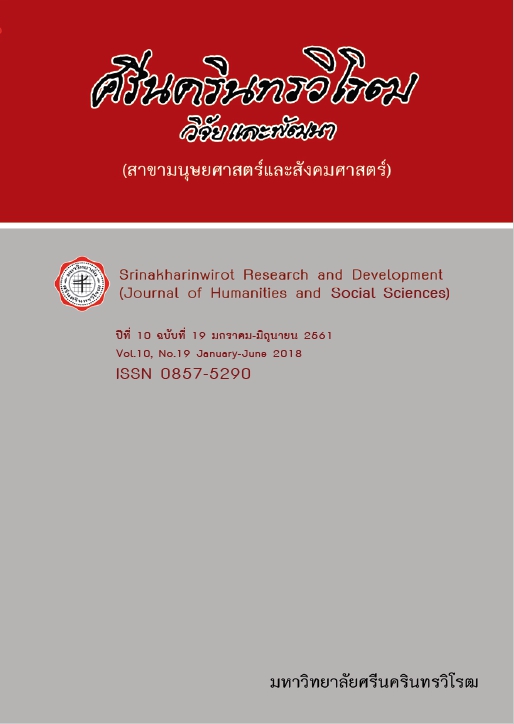การศึกษาผลการใช้หลักสูตรบูรณาการสร้างสรรค์ผลงานบนแท็บเล็ตโดยใช้แฟ้มสะสมผลงานอิเล็กทรอนิกส์ผ่านสื่อสังคมระดับประถมศึกษา (THE STUDY OF USING CREATING INTEGRATION CURRICULUM ON TABLET BY USING E-PORTFOLIO VIA SOCIAL MEDIA FOR ELEMENTARY)
Keywords:
Curriculum Integration, Creation, Instructional with Tablet, e-Portfolio, Social MediaAbstract
The purpose of this study were (1) to compare mean of pre-test and post-test score by learning with the creating integration curriculum on tablet by e-portfolio via social media for elementary (2) to study users’ opinion from learning with the creating integration curriculum on tablet by e-portfolio via social media for elementary. The samples were 24 Grade 6 students from one classroom by using cluster random sampling. The research instruments were a pre-test paper, a post-test paper, the creating integration curriculum on tablet by e-portfolio via social media for elementary and a post-study opinion survey. Statistics used in data analysis were t-test dependent and content analysis.
The study findings revealed as follow: (1) The students who study with the creating integration curriculum on tablet by e-portfolio via social media for elementary had post-test score higher than pre-test score significantly at 0.05 levels. (2) All students had positive opinion on learning with the creating integration curriculum on tablet by e-portfolio via social media for elementary as they knew more applications and were able to apply in the classroom.
Downloads
References
[2] คณะกรรมการจัดทำยุทธศาสตร์ชาติ. (2559). ร่างกรอบยุทธศาสตร์ชาติ ระยะ 20 ปี (พ.ศ. 2560 - 2579). สืบค้นเมื่อ 15 กุมภาพันธ์ 2561, จาก http://www.nesdb.go.th/download/document/ร่างยุทธศาสตร์ชาติ%20ระยะ%2020%20ปี%20(พ.ศ2560%20-%202579).pdf
[3] วิจารณ์ พานิช. (2555). วิถีสร้างการเรียนรู้เพื่อศิษย์ในศตวรรษที่ 21. กรุงเทพฯ: มูลนิธิสดศรี-สฤษดิ์วงศ์.
[4] นพดล กองศิลป์. (2559). การพัฒนาหลักสูตรบูรณาการสร้างสรรค์ผลงานบนแท็บเล็ตโดยใช้ แฟ้มสะสมผลงานอิเล็กทรอนิกส์ผ่านสื่อสังคมระดับประถมศึกษา. ใน การประชุมวิชาการระดับชาติ “มศว วิจัย” ครั้งที่ 9. หน้า 564-573. กรุงเทพฯ: สถาบันยุทธศาสตร์ทางปัญญาและวิจัย มหาวิทยาลัยศรีนครินทรวิโรฒ.
[5] กระทรวงเทคโนโลยีสารสนเทศและการสื่อสาร. (2554). กรอบนโยบายเทคโนโลยีสารสนเทศและการสื่อสาร ระยะ พ.ศ. 2554-2563 ของประเทศไทย. กรุงเทพฯ: กระทรวงเทคโนโลยีสารสนเทศและการสื่อสาร.
[6] Kanokphon Chantanarungpak. (2015). Using e-Portfolio on Social Media. In Procedia – Social and Behavioral Sciences. 186: 1275-1281.
[7] Anderson, L.W. & Krathwohl, D.R. (2001). A Taxonomy for Learning, Teaching, and Assessing. New York: Longman.
[8] พิมพันธ์ เดชะคุปต์; และคณะ. (2556). การสอนคิดด้วยโครงงานการเรียนการสอนแบบบูรณาการ ทักษะใน ศตวรรษที่ 21. กรุงเทพฯ: โรงพิมพ์แห่งจุฬาลงกรณ์มหาวิทยาลัย.
[9] Becta ICT Research. (2005). Tablet PCs in schools: Case study report: A report for Becta by the Open University. Retrieved February 22, 2016, from http://oro.open.ac.uk/6407/1/BTE_case_study_ print.pdf
[10] Reeves, T.C.; Herrington, J.; & Oliver, R. (2002). Authentic activity as a model for web-based learning. Paper presented at the annual meeting of the American Educational Research Association. New Orleans. Retrieved February 15, 2018, from http://www.academia.edu/2705227/Authentic_activity_as_a_model_for_web-based_learning
[11] Scott J. Warren; and Jenny S. Wakefield. (2013). Learning and Teaching as Communicative Actions. In Using Social Media Effectively in the Classroom : Blogs, Wikis, Twitter, and more. New York: Routledge.
Downloads
Published
How to Cite
Issue
Section
License
Srinakharinwirot Research and Development Journal of Humanities and Social Sciences is licensed Under a Creative Commons Attribution-NonCommercial-NoDerivs 4.0 International (CC-BY-NC-ND 4.0) License, Unless Otherwise Stated. Please Read Journal Policies Page for More Information on Open Access, Copyright and Permissions.



